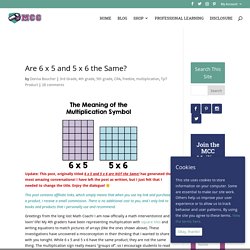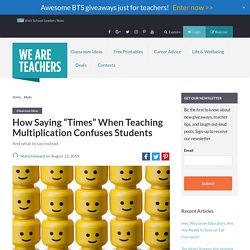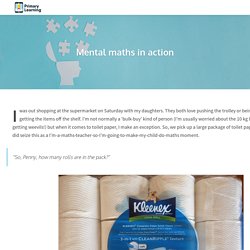Grade 3
Twitter. Twitter. Are 6 x 5 and 5 x 6 the Same?
Update: This post, originally titled 6 x 5 and 5 x 6 are NOT the Same!

Has generated the most amazing conversations! I have left the post as written, but I just felt that I needed to change the title. Enjoy the dialogue! This post contains affiliate links, which simply means that when you use my link and purchase a product, I receive a small commission. There is no additional cost to you, and I only link to books and products that I personally use and recommend.
Twitter. Twitter. Twitter. The Multiplication Course by Steve Wyborney - Steve Wyborney's Blog: I'm on a Learning Mission.
The Multiplication Course by Steve Wyborney is finished and completely ready!

It is a highly interactive multiplication course – on YouTube – with 156 short videos. They are completely ready for all students, all teachers, all parents, everyone! The course teaches students deep, rich, and important multiplication concepts while they are also learning multiplication facts. It also puts students in control of their learning, allowing them to pause the think deeply, allowing them time to write, allowing them to discover important math ideas.
The animated videos are organized in 12 chapters – and each chapter is in a playlist on YouTube. If you are looking for a multiplication resource for… your students… your children… your class.. or your entire school…
Twitter. How many now? @BerkeleyEverett…
My daughter’s choice of activity today: Are you offering choice for your kids? Do your kids WANT to do their math? #mtbos #iteachmath #distancelearning #homeschooling…
Thank you @gregtangmath for the idea to have my students notice 1 compared to 10, compared to 100, compared to 1,000. Such a better visual than the cube. @RuckerRocks…
Representing Multiples. Looking for a work product that will allow your kiddos creativity, but also show that they understand multiples?

Check out this Multiples Madness poster for representing multiples. The first page of the document is an example you can show to the kids.
I was AMAZED at how quickly my students could “shift” numbers to make them easier to subtract! This strategy is □! Thanks @gregtangmath! #leadthewaylf…
Why Do Students Mix Up Area And Perimeter?
If you think others need to see this, share it on one of the sites below by clicking on the button. If you’ve ever taught students how to find the area or perimeter of a shape, you won’t be surprised to read that students commonly confuse the two measurements. For example, if you ask a student to find the perimeter of a rectangle, they will often give you the rectangle’s area.
Based on my experiences, this seems to be a pretty typical outcome for all math educators. I realize that we’ve come to accept this as normal, but have you ever thought about why it happens? Does this also happen in real life? This makes me wonder about whether it’s possible that the reason students confuse area and perimeter is because we often present problems without context or with fake/trivial contexts. To better illustrate what I mean, consider the problem below that comes from the outgoing California standardized test prior to the Common Core State Standards.
Multiply vs. Times: How To Use Proper Multiplication Vocabulary. Math vocabulary can be tricky, full of words that students have never heard before or words that have alternate meanings in math than they do in daily life.

(I’m looking at you “mean.”) Choosing our words carefully can have a big impact on student understanding, especially when it comes to multiplication.
Adina R sur Twitter : "#mtbos Looking for a way to introduce perimeter to elementary students without defining it for them. This is my 1st idea. @tracyjoproffitt @math6teacher @MathMinds @BerkeleyEverett @TracyZager @KristenMAcosta @HTmathematics @Mathlet. Another Way to Subtract. Below are examples from two fifth graders I interviewed.

I asked each to use paper and pencil to figure out the answer to 5000 – 328. Both students got the correct answer of 4672, and it took both of them about the same amount of time to complete the work. Alexa’s solution shows how she applied the standard algorithm that she had been taught. As she worked, Alexa gave clear explanations about the steps she used, demonstrating her proficiency with the procedure. Jesús solved the problem in a different way. The standard algorithms that we teach are effective and efficient, and it’s important for students to learn and practice these paper-and-pencil procedures.
Teaching for Deep Understanding. Mental maths in action – Primary Learning. I was out shopping at the supermarket on Saturday with my daughters.

They both love pushing the trolley or being in charge of getting the items off the shelf. I’m not normally a ‘bulk-buy’ kind of person (I’m usually worried about the 10 kg bag or rice getting weevils!) But when it comes to toilet paper, I make an exception. So, we pick up a large package of toilet paper, and yes, I did seize this as a I’m-a-maths-teacher-so-I’m-going-to-make-my-child-do-maths moment. “So, Penny, how many rolls are in the pack?” At this moment, I could have stepped in and helped continue the count, but it’s important to notice the beginnings of ‘productive struggle1’ and let them, for want of a better word, fester.
5 × 9 Is More Than 45 – Steve Wyborney's Blog: I'm on a Learning Mission.
What Is It Between? – The intricacies of teaching rounding – Elementary Mathematics – Round Rock ISD. Down the Rounding Rabbit Hole. Why I Like Using Open Number Lines...
This post was originally published on Marilyn Burns’ Math Blog.

When I visited Joe’s third-grade class, he was concerned about the results on his students’ homework from the day before. It was a computation practice assignment, and practically all of the children had either gotten the wrong answer to 503 – 398 or indicated that it was “too hard.” (Writing “too hard” was an option they had to let Joe know when they couldn’t figure out how to do a problem. This gave Joe useful feedback about what he needed to work on, either with the entire class or with specific students.) The problems on the homework assignment were all written vertically, so that students could apply the standard algorithms they were learning.
Multiplication Move On Game Board (ADAPTED VERSION), Directions, and Math Talk Card.pdf. Fraction Talking Points: 3rd Grade. What is Multiplication? – Illustrative Mathematics. When You Multiply by 10, Just Add a Zero? Horrors!?!
We Ask, We Listen, We Learn is one of the early blog posts I wrote.

(I posted it on January 5, 2015.) The post includes interviews of several students answering the question: How much is 12.6 x 10? One of the video clips shows Mallika Scott interviewing Natasha, who explains how she decided on the incorrect answer of 12.60.
Robertkaplinsky. Most Misunderstood Math Standards in Grade 3. When I was asked to continue the series of the Most Misunderstood Standards for grades 3–5, I immediately said yes!

After all, the series is a perfect combination of my two most favorite things: math and writing! Over the course of my 18-year career as a teacher and instructional coach, I have had the privilege to learn deeply about the standards, the Shifts, and the mathematical practices from some of the best math educators in the country. With their guidance, I developed an understanding of what excellent math instruction is in an elementary school classroom. As a math coach, I often plan with teachers and observe in their classrooms. We use the Instructional Practices Guide for Coaching as our North Star.
Mathematical Musings. Somewhere back in days of Facebook fury about the Common Core there was a post from an outraged parent whose child had been marked wrong for something like this: 6×3=6+6+6=18.

Apparently the child was supposed to do $$ 6 \times 3 = 3 … Continue reading Ways of thinking and ways of doing Over at the IM Virtual Math Coach we got a question about the following grade 8 standard: 8.F.A.3. Interpret the equation y=mx+b as defining a linear function, whose graph is a straight line; give examples of functions that are not linear. For example, the function A=s2 giving the area … Continue reading How do you tell if a function is linear? In her book Knowing and Teaching Elementary Mathematics, Liping Ma wrote about this question and how teachers responded to it: Write a story problem for 1¾÷½.










